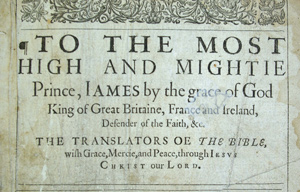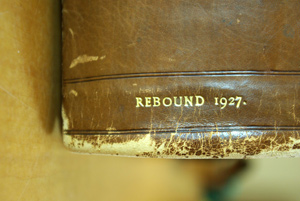The Harold B. Lee Library Copy of the King James Bible

L. Tom Perry Special Collections in Harold B. Lee Library possesses an original first edition copy of the King James, or Authorized, Bible. This copy is in fact a first edition, second issue of the King James Version. The first issue was printed in 1611; for the second issue, the type was completely reset as a page-by-page reprint as early as 1611, though a portion of the Old Testament (Judges 13-Exekiel 20) was destroyed during the course of the reprinting and so delayed the finished product. Copies of the second issue usually include the date 1611 on the title page of the New Testament, but often are dated 1613 on the opening title page. The first issue of the first edition is sometimes called the Great "He Bible", which refers to a reading in Ruth 3:15, "he went into the citie." In the second issue, called the "She Bible", the verse was corrected to "she went." Other typographical errors confirm that the BYU copy is a first edition, second issue of the King James Bible, including several which appear on the first page of the dedicatory text: "OE" for "OF" in the sixth line of the header; "Chkist" for "Christ" in the eighth line of the header (see illustration A). Another famous typographical error in the first edition, second issue is the reading "Judas" for Jesus in Matthew 25:36.

The first edition copy of the King James Bible at BYU has several flaws. It is missing the engraved title page, though a facsimile in a sepia-tone ink (dated 1611) has been bound into the BYU copy. The final leaf of the Bible (representing Revelations 20:12 through 22) is also missing; facsimiles have been supplied from a microfilmed copy of another first edition, second issue King James Bible. BYU's copy has been trimmed at some point, meaning that at some point the edges of the pages were cropped, likely during a rebinding, to create a uniform text block. As a result, the margins have been significantly reduced in size, sometimes with losses to the Bible's page headings and with some loss of text on two pages in the New Testament. A number of pages have been torn or damaged, and repairs have been made by gluing in blank paper of a similar shade to reinforce the paper or to fill in gaps and make each page the same size (see illustration B).

The provenance, or ownership history, of BYU's copy of the King James Bible has been obscured by time. The Harold B. Lee Library no longer has record of when the Bible came into its possession; the library's electronic catalog record and the old card catalog record which is still kept by L. Tom Perry Special Collections contain no information about how or when the library acquired its copy of the King James Bible. The volume was rebound in a tan calfskin in 1927—we know this because the binder stamped the date onto the lower edge of the spine (see illustration C). Unfortunately, the rebinding of the book obliterated any earlier clues to the Bible's provenance that might have been found on its covers, endpapers, or flyleaves.
A bookplate attached to the front endpaper indicates that one former owner of BYU's copy was Alfred Walter Hitchings, and given that there are no other ownership marks or other bookplates within the front or rear covers, it is most likely he who had the volume rebound. Alfred Walter Hitchings was a businessman from Nottingham, England, who died in April 1936. He was also a book collector who amassed a substantial collection of Bibles, New Testaments, and early works by sixteenth-century Bible translator William Tyndale. Hitchings was particularly interested in Tyndale because he may have been one of Hitchings' ancestors; Hychins, or Hutchins or Hitchings, was an alternative family name for Tyndale. The earliest extant records of Tyndale, from when he received his BA at Oxford University in 1512, list him as "William Hychyns." An image of "The Tyndale monument on the Thames Embankment"—the 1884 bronze statue by Sir Joseph Boehm which stands in London's Victoria Embankment Gardens— printed on glossy paper has been bound into the front of the BYU copy of the King James Bible, further proof that the 1927 rebinding was most likely undertaken while it was in the possession of Alfred Walter Hitchings.
Hitchings bequeathed his collection of Bibles to the Gloucester Public Library (now Gloucester County Library) upon his death. William Tyndale was born in Gloucestershire and this connection may have been one reason for Hitchings' choice of repositories. The collection contained over 100 Bibles dating between 1540 and 1906, around 50 New Testaments dating between 1519 and 1926, and several works by Tyndale and English Protestant martyr John Frith. The Hitchings Collection currently holds one 1611 first edition copy of the King James Bible.
The BYU copy of the 1611 King James Bible contains no markings to suggest that it was ever a part of the Hitchings Collection in the Gloucester County Library, and correspondence files kept by the Gloucester Library relating to the Hitchings Collection do not mention any sales or dispersal of Bibles to other organizations or institutions. Thus it is highly probable that the King James Bible now at BYU was sold by Alfred Walter Hitchings at some point between the book's rebinding in 1927 and Hitchings' death in 1936.
There are few clues about the Bible's history after it left Hitchings' collection. Besides Hitchings' bookplate, the front endpaper features the penciled notes of an unidentified book dealer, which note the book's condition and identify the Bible as a first edition, second issue of the King James version. The book dealer has also signed the book in pencil at the top right-hand corner of the rear endpaper, but the signature is unreadable. A search of American and British auction records yielded no matches which fit the description of BYU's copy, so the Bible's path from Hitchings to BYU cannot be definitively traced. Perhaps in the future, Harold B. Lee Library records about the Bible's acquisition will come to light, but for now, its full provenance remains lost to time.